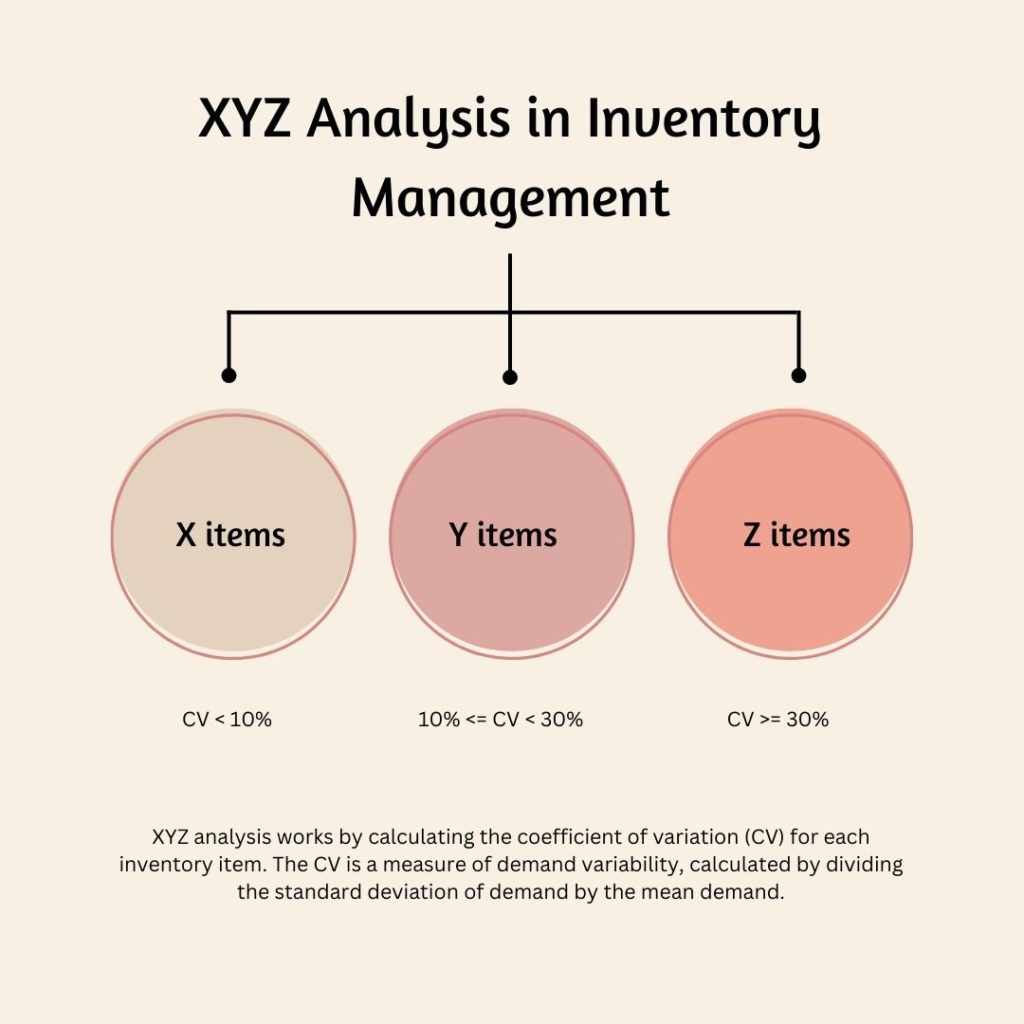Editorial Note: We are an inventory management software provider. While some of our blog posts may highlight features of our own product, we strive to provide unbiased and informative content that benefits all readers.
XYZ analysis is a method of inventory classification that groups items based on their demand variability.
It is often used in conjunction with ABC analysis, which groups items based on their value. XYZ analysis can help businesses to optimize their inventory management by identifying items that require different levels of attention.

How does XYZ analysis work?
XYZ analysis works by calculating the coefficient of variation (CV) for each inventory item. The CV is a measure of demand variability, calculated by dividing the standard deviation of demand by the mean demand. Items with a CV of less than 10% are classified as X items, items with a CV of 10-30% are classified as Y items, and items with a CV of over 30% are classified as Z items.
Benefits of XYZ analysis
XYZ analysis offers a number of benefits for businesses, including:
- Improved inventory forecasting accuracy
- Reduced stockouts and overstocks
- Lower inventory costs
- Improved customer service levels
Classifying inventory items using XYZ analysis
To classify inventory items using XYZ analysis, businesses can follow these steps:
- Calculate the CV for each inventory item.
- Group items into the following categories:
- X items: CV < 10%
- Y items: 10% <= CV < 30%
- Z items: CV >= 30%
Using XYZ analysis to optimize inventory management
Once inventory items have been classified using XYZ analysis, businesses can use this information to optimize their inventory management practices. For example:
- Inventory planning and forecasting: X items are the easiest to forecast demand for, while Z items are the most difficult. Businesses can use this information to develop more accurate inventory plans and forecasts.
- Safety stock levels: Safety stock is inventory that is held in reserve to protect against stockouts. Businesses can use XYZ analysis to determine appropriate safety stock levels for each item, based on its demand variability.
- Reorder points: The reorder point is the level of inventory at which a new order should be placed. Businesses can use XYZ analysis to determine appropriate reorder points for each item, based on its demand variability and lead time.
Example of XYZ analysis in inventory management
The following table shows an example of how XYZ analysis can be used to classify inventory items:
| Item | Demand variability (CV) | XYZ classification |
|---|---|---|
| Product A | 5% | X |
| Product B | 15% | Y |
| Product C | 35% | Z |
Based on this information, the business could develop the following inventory management strategies:
- Product A: Product A has low demand variability, so the business can use a simple forecasting method and maintain a relatively low safety stock level.
- Product B: Product B has moderate demand variability, so the business should use a more sophisticated forecasting method and maintain a higher safety stock level.
- Product C: Product C has high demand variability, so the business should use a very sophisticated forecasting method and maintain a very high safety stock level.
Best practices for using XYZ analysis
Here are some best practices for using XYZ analysis:
- Use historical data to calculate the CV for each inventory item.
- Review the XYZ classification of items on a regular basis, as demand variability can change over time.
- Use XYZ analysis in conjunction with ABC analysis to get a more complete picture of inventory management needs.
- Consider other factors, such as item value and lead time, when developing inventory management strategies for each item.
Conclusion
XYZ analysis is a powerful tool that can help businesses to optimize their inventory management. By classifying inventory items based on their demand variability, businesses can develop more accurate inventory plans and forecasts, reduce stockouts and overstocks, lower inventory costs, and improve customer service levels.
Take a Quiz Test - Test Your Skill
Test your inventory management knowledge. Short multiple-choice tests, you may evaluate your comprehension of Inventory Management.
